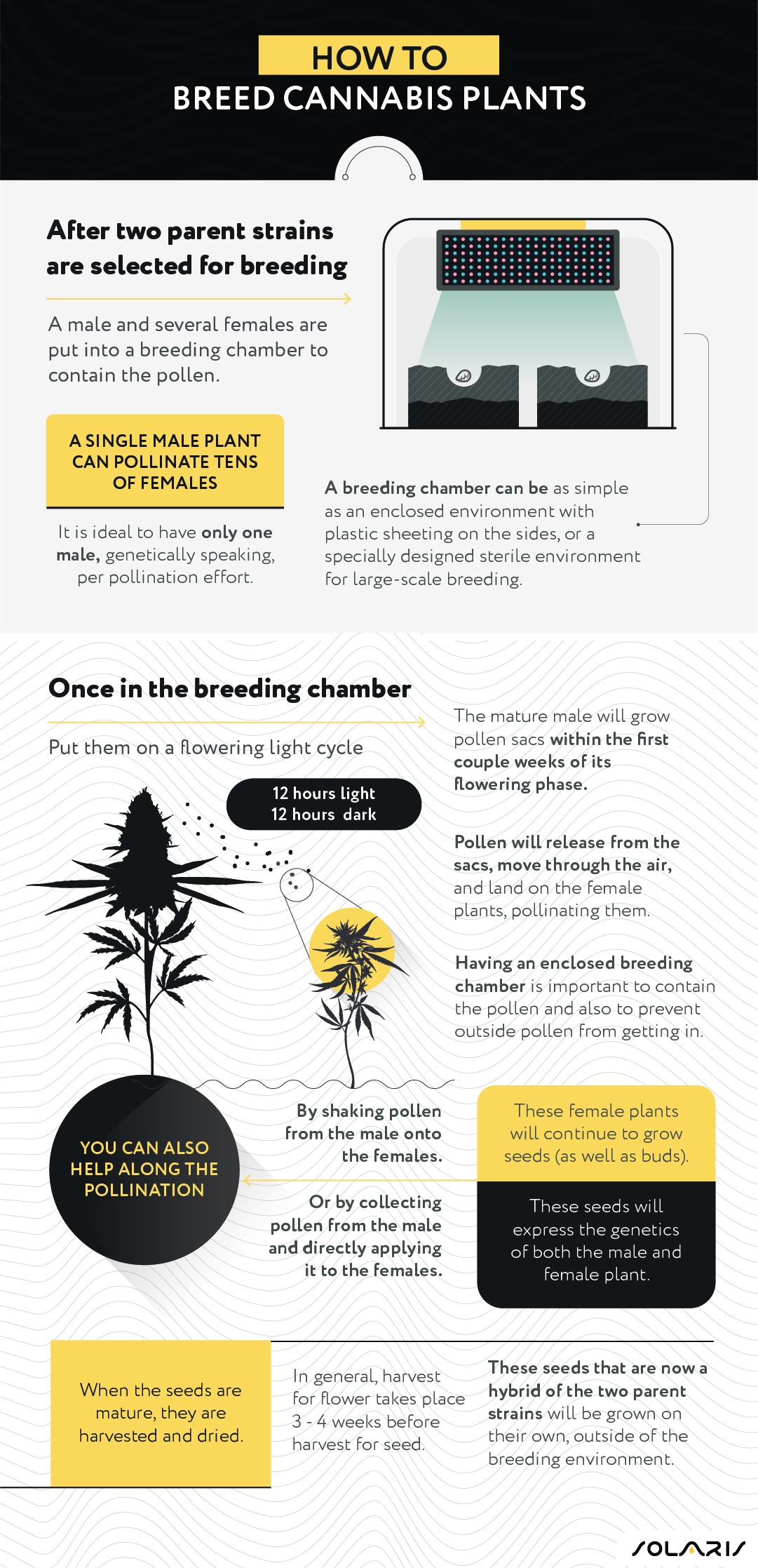Plant breeding is a fundamental process of growing cannabis. Breeding is highly technical and typically done on a commercial scale, but with legalization increasing, breeding is becoming more popular. You can even do it yourself.
When chromosomes of a cannabis plant pair with another the plant will evolve and create a new genetic lineage that is a genetic copy of both parents. With the advancement of seed banks and nurseries, obtaining great genetics is easier now than ever.
Cannabis breeders typically breed to purify and strengthen strains, combine strain traits, or enhance specific characteristics like higher yields, specific aromas, potency, and many other things.
When growing and breeding, it is important to know where your seeds come from and what kind of genetics they have. If the seed breeder cannot give you a detailed history of how a packet of seeds was bred or what they were crossed with, you never really know what you are getting.
The basics of breeding
Cannabis plants can be either male or female. Cannabis consumers are mainly concerned with female plants because only females produce the sticky buds that we all know and love. But male cannabis plants are important for the breeding process, as they are needed to pollinate the bud-producing females.
Take the strain Super Lemon Haze as an example. It is a hybrid of Super Silver Haze and Lemon Skunk. At some point, the breeder decided that they liked some attributes of Super Silver Haze and some of Lemon Skunk and decided to combine the two.
To do this, you need a male of one strain to pollinate a female of the other. Once pollinated, the female will then produce seeds that express the genes of both the male and female plant. Those seeds will be harvested and grown separately.
Why is breeding useful?
This complex interplay of selection for desirable traits requires a great deal of time, effort, and resources by the breeder. Cannabis breeding as practiced today began in the 1970s. From the outset, one of the main goals of breeding was to increase the potency of cannabis, which started at a measly 3-5 percent of THC by mass. Cannabis potency has steadily increased to an average of around 17-25 percent in modern strains. Modern breeders seek unique aroma traits to make their products stand out among the competition. Traits that favor resistance to pests are sought as mold and insects adapt to feeding on cannabis.
The process of breeding happens over generations. A plant that has a shorter flowering time but is vulnerable to pests could be crossed with a plant that has reputable resistance to a variety of pests.
The first generation of offspring produced from an initial cross between two strains are called F1 hybrids; some may display better pest resistance than others. The plants can then be crossed again to increase these traits further, producing a second-generation, or F2 hybrids.
This process can be repeated, utilizing the best plants from each generation to selectively fix these traits. A breeder can infer that traits are fixed in their hybrid line after rounds of cross-breeding the best male and female hybrids from each crop when subsequent generations do not differ in presentation of targeted traits seen in earlier generations.
At this point, the genetics of the hybrid line is considered stable and should produce plants identical to the stabilized hybrid parents. Once genetics have been stabilized in a strain, their seeds can be sold to individuals looking to grow a similar crop. However, these individuals often live in very different climates, which can affect the outcome of the crop.
Initially, the seeds are simply grown in the new climate. Of those newly grown plants, the ones that displayed better adaptation to their environmental conditions will be crossed with each other to produce seeds that yield the greatest acclimation to their new environment.
Landrace and heirloom strains
Generations of growers before us have traveled the world finding landrace strains of cannabis so that we all get to benefit from a huge pool of genetics for our breeding programs. A landrace strain is a local cultivated strain; a strain that has been developed by residents of that area.
So a grower might visit an area where the local growers have a unique strain of cannabis. Sometimes their local strain has new desirable traits that have not been seen before (a particular color, taste, smell, potency, etc).
Many growers will take seeds to grow themselves. A landrace strain collector might bring back dozens of seeds so that the genetics of these local strains are preserved. These seeds are then mixed with other breeding stock to capture those traits in new plants.
The ruderalis plant
A famous example of a local plant that rocked the growing world is the “ruderalis” plant. People might not consider it a landrace since it does not seem to be actively cultivated by local growers, but it is a local plant that has been mixed into many breeding programs around the world.
In the wild, ruderalis is a small, scraggly cannabis plant that grows in extremely cold climates with short summers. The buds are not potent and the plants are scrawny, but these plants had one very important trait; the ability to “auto-flower” after just a few short weeks, regardless of light schedules.
Unlike most other strains, auto-flowering strains are not dependent on light schedules. Instead, they start growing buds and are ready to harvest in just a few months no matter what happens.
At some point, an enlightened grower realized that this auto-flowering trait could be useful to growers. Yet the wild ruderalis strain would never be useful to growers in its original form, as it had low levels of THC and the buds were tiny. So breeders began crossing auto-flowering strains with quality high-potency cannabis strains.
Original crosses created relatively small plants with low potency, but growers have continued to refine and stabilize auto-flowering strains. Over the last decade or so, many breeders from around the world have been working together to isolate the auto-flowering trait in plants that produce high-potency buds and big yields.
By continuously breeding the ruderalis plants with potent cannabis strains, we now have strains that have kept that auto-flowering characteristic but are just as potent and beautiful as modern strains. Several breeders now carry an auto-flowering version of their regular strains.
In just a few years, breeders were able to take a scraggly hemp plant and breed out everything except the auto-flowering trait. This gave breeders the power to create potent auto-flowering strains around the world.
How to breed cannabis plants

After two parent strains are selected for breeding, a male and several females are put into a breeding chamber to contain the pollen. A breeding chamber can be as simple as an enclosed environment with plastic sheeting on the sides, or a specially designed sterile environment for large-scale breeding.
A single male plant can pollinate tens of females. It is ideal to have only one male, genetically speaking, per pollination effort. A healthy male can pollinate up to 20 females. Any grower who has accidentally grown a male that pollinated a crop will know that it can easily fill your whole crop with seeds.
Once in the breeding chamber, you can grow the plants vegetatively for a few weeks to let them get bigger, but it is not necessary. Put them on a flowering light cycle; 12 hours of light, 12 hours of dark.
The mature male will grow pollen sacs within the first couple weeks of its flowering phase. Pollen will release from the sacs, move through the air, and land on the female plants, pollinating them. Having an enclosed breeding chamber is important to contain the pollen and also to prevent outside pollen from getting in.
You can also help along the pollination effort by shaking pollen from the male onto the females, or by collecting pollen from the male and directly applying it to the females. These female plants will continue to grow and flower, during which they will grow seeds (as well as buds). These seeds will express the genetics of both the male and female plant.
When the seeds are mature, they are harvested and dried. In general, harvest for flower takes place three to four weeks before harvest for seed. These seeds that are now a hybrid of the two parent strains will be grown on their own, outside of the breeding environment.
Phenotypes
But the process does not end there. The hybrid strain that you buy at the dispensary has likely gone through many generations of breeding to strengthen its genes and to ensure that its descendants are healthy and consistent.
Just as you and your sibling might have different physical attributes from your parents, each seed created from a round of cross-pollination will have different attributes from its parent strains. Maybe you have your father’s eyes and your mother’s hair, but your sister has your mother’s eyes and hair.
Each cannabis seed is unique and will express different traits, and different combinations of traits, from one or both of the parent strains. These seeds with various expressions are called phenotypes.
A plant that produces a set of phenotypes that have a lot of variety are said to be heterozygous. With cannabis, you typically want seeds that are homozygous, which are ones that have the same set of genes. Homozygosity ensures that a plant will consistently produce the same seeds with the same genetic makeup over and over again, ensuring that buyers and consumers will get the same plant or seed time and again.
After a strain is crossed, a breeder will then have to select which phenotype of the new strain they like best. For large-scale growers, they want to choose the best phenotype for mass production.
Referring back to the Super Lemon Haze example, this strain takes a lot of its bud structure, trichome and resin production, and overall appearance from Super Silver Haze. But it takes its flavors and aromas from Lemon Skunk.
Lemon Skunk also tends to grow extremely tall and has loose buds, whereas Super Silver Haze grows smaller and has denser buds. By selecting specific phenotypes, a breeder can pick one that has the attributes they want to keep. In this case, a phenotype that has the structure and bud density of Super Silver Haze and the flavors and aromas of Lemon Skunk.
Most likely, there were early phenotypes of Super Lemon Haze that grew tall and loose like Lemon Skunk, or tasted more like Super Silver Haze. But the breeder discarded those phenotypes and kept growing the ones that have the attributes of what we now know as Super Lemon Haze.
Backcrossing
High-quality breeding still does not stop there. Once a breeder has crossed a strain and narrowed down a phenotype and finally has the one they like, they will usually backcross that strain to strengthen its genetics.
Backcrossing is a practice where a breeder will cross-pollinate the new strain with itself or a parent which is essential, inbreeding the strain. This makes the strain more homozygous, and strengthens its genetics and desirable characteristics, and also ensures that those genes continue to pass down from generation to generation.
The hybrid that you bought from the dispensary has gone through months and even years of growing, crossing, and backcrossing, as well as a selection process to pick the best phenotype of that strain.
Breeding is about time and patience. To be a breeder, you have to be willing to accept the fact that you will not have uniformity in the first generation of offspring. Making seeds that will actually reflect the final product takes time, and it takes more than just a one-off cross.


